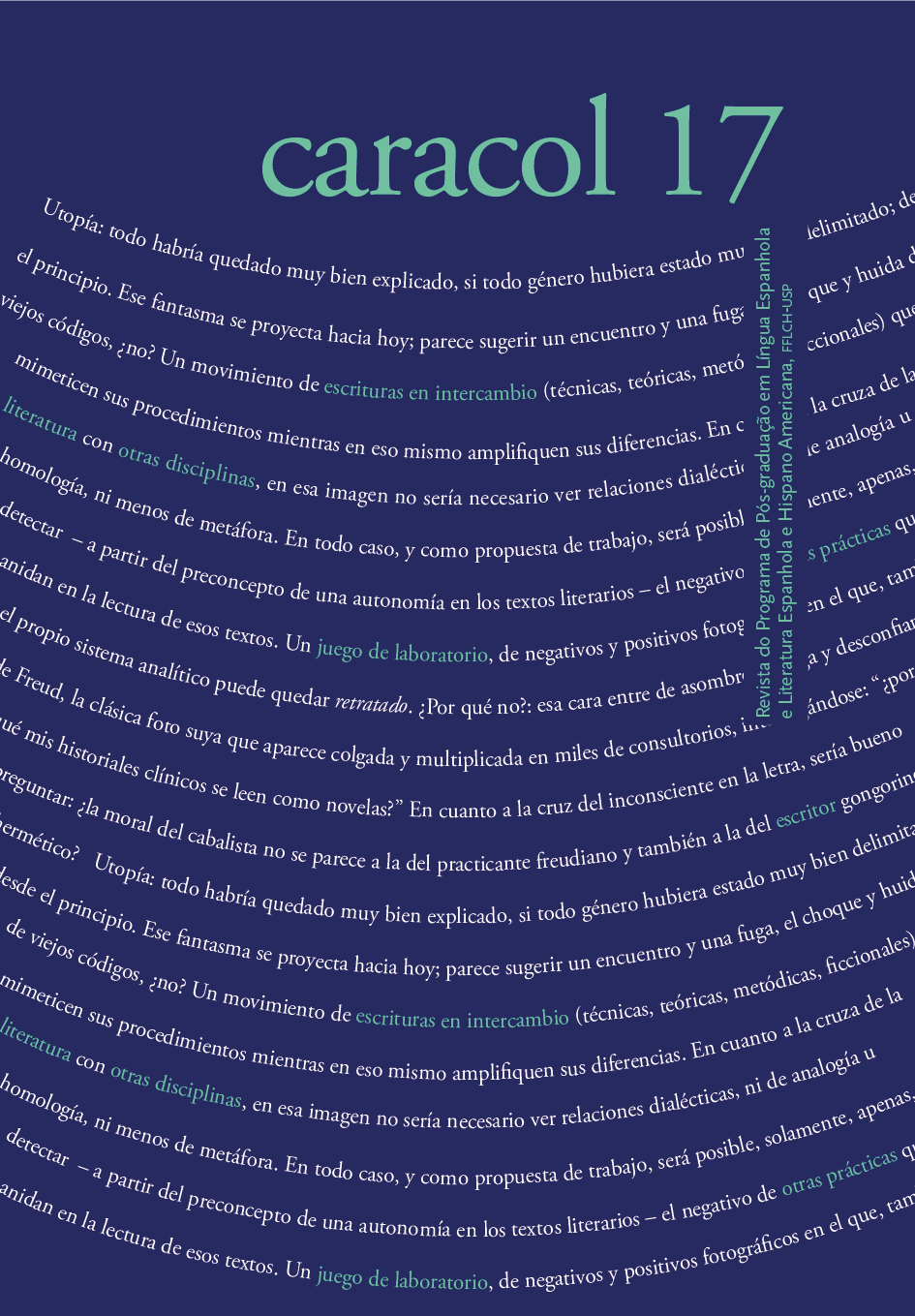Collector, artist, monster: The Duke of Bomarzo in María Negroni’s La Boca del Infierno
DOI:
https://doi.org/10.11606/issn.2317-9651.v0i17p301-324Keywords:
poetry, rewriting, collector, monster, radicant aestheticsAbstract
Considering the pronounced link between Manuel Mujica Láinez’s Bomarzo (1962) and María Negroni’s La Boca del Infierno (2009), this article proposes a reading centred in the updated significations carried out by Negroni’s rewriting operation. She has already performed this rewriting strategy of a certain zone of tradition in previous works, operation that allows the examination of the characters that defines a radicant aesthetics. This paper examines the correspondence of the speech subject in both books, remarking both the subject’s particular traces (orphan, collector, artist and “monster”) and some differences concerning his representation in each text. Thus, the mouth/grotto/crypt of hell created by Negroni opens up to the singularity/otherness tensions and proliferates from Bomarzo’s story propitiating new roots that develops a radicant poetics.
Downloads
References
Bachelard, Gaston. La tierra y las ensoñaciones del reposo. Ensayo sobre las imágenes de la intimidad. México: Fondo de Cultura Económica, [1948] 2014. Traducción: Rafael Segovia.
Benjamin, Walter. Desembalo mi biblioteca. El arte de coleccionar. Barcelona: Centellas, 2012. Traducción: Fernando Ortega.
Blanchot, Maurice. La escritura del desastre. Caracas: Monte Ávila, [1983] 1990. Traducción: Pierre de Place.
Bourriaud, Nicolas. Radicante. Buenos Aires, Adriana Hidalgo, 2009. Traducción: Michèle Guillemont.
Chevallier, Jean. Diccionario de los símbolos. Barcelona: Herder, 1986. Traducción: Manuel Silvar y Arturo Rodríguez.
Corominas, Joan. Breve diccionario etimológico de la lengua castellana. Madrid: Gredos, 1976.
Giorgi, Gabriel. “Política del monstruo”. En Revista Iberoamericana, Vol. LXXV, N° 227, 2009, p.323-329.
González Serrano, Pilar. “Catábasis y resurrección”. En Espacio, Tiempo y Forma, Serie II, Historia Antigua, N° 12, 1999; p.129-179.
Kamenszain, Tamara. La boca del testimonio. Lo que dice la poesía. Buenos Aires: Norma, 2007.
Kristeva, Julia. Sol negro. Depresión y melancolía. Buenos Aires: Waldhuter, [1987] 2015. Traducción: Víctor Goldstein.
Ludmer, Josefina. El cuerpo del delito. Un manual. Buenos Aires: Perfil, 1999.
Monteleone, Jorge. “La gruta del poeta”. En Negroni, María. La Boca del Infierno. México: Mantis, 2009, p.7-10.
Mujica Láinez, Manuel. Bomarzo. Buenos Aires: Sudamericana, [1962] 1967.
Negroni, María. Islandia. Caracas: Monte Ávila, 1994.
Negroni, María. El sueño de Úrsula. Buenos Aires: Seix Barral, 1998.
Negroni, María. Museo negro. Buenos Aires: Norma, 1999.
Negroni, María. La boca del infierno. México: Mantis, 2009.
Nerval, Gérard de. “El desdichado”. En Paz, Octavio. Versiones y diversiones. Barcelona: Galaxia Gutenberg, 2000; p.21.
Secreto, Cecilia. “La travesía de los géneros. El espacio de la reescritura”. En Piña, Cristina (ed.). Literatura y (pos)modernidad. Buenos Aires: Biblos, 2008; p.87-119.
Virgilio. Eneida. Buenos Aires: Losada, 2006. Traducción: Eugenio de Ochoa.
Downloads
Published
Issue
Section
License
Copyright (c) 2019 Rayén Daiana Pozzi

This work is licensed under a Creative Commons Attribution-NonCommercial 4.0 International License.
Authors who publish in this journal agree to the following terms:
- Authors retain copyright and grant the journal the right of first publication, with the work simultaneously licensed under a Creative Commons Attribution License, which permits the dissemination of the work with recognition of authorship and initial publication in this journal.
- Authors are allowed to enter into additional contracts separately for non-exclusive use of the version of the work published in this journal (such as publication in an institutional repository or as a book chapter), with recognition of authorship and initial publication in this journal.
- Authors are allowed and encouraged to publish and distribute their work online (e.g., in institutional repositories or on their personal page) at any point before or during the editorial process, as this can generate productive changes, as well as increasing the impact and citation of the published work (see The effect of open access…).



